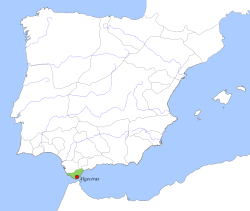The Taifa of Algeciras (Arabic: طائفة الجزيرة) was a medieval Muslim taifa kingdom in what is now southern Spain and Gibraltar, that existed from 1035 to 1058.
Taifa of Algeciras طائفة الجزيرة (Arabic) | |||||||||
|---|---|---|---|---|---|---|---|---|---|
| 1035–1058 | |||||||||
 Taifa Kingdom of Algeciras, c. 1037. | |||||||||
| Capital | Algeciras | ||||||||
| Common languages | Arabic, Mozarabic, Hebrew | ||||||||
| Religion | Islam, Catholicism, Judaism | ||||||||
| Government | Monarchy | ||||||||
| Emir | |||||||||
• 1035–1048 | Muhammad ibn al-Qasim | ||||||||
• 1048–1058 | al-Qasim al-Wathiq | ||||||||
| Historical era | Middle Ages | ||||||||
• Downfall of Caliphate of Córdoba | 1035 | ||||||||
• Conquered by the Taifa of Seville | 1058 | ||||||||
| Currency | Dirham and Dinar | ||||||||
| |||||||||
| Today part of | Spain Gibraltar | ||||||||
History
editThe taifa was created in 1013, in the wake of the disintegration of the caliphate of Córdoba which began after 1009. When Sulayman ibn al-Hakam took control of the caliphate, he gave Algeciras to the Hammudids, a dynasty who had helped him in gaining the power. The first king of Algeciras was al-Qasim al-Ma'mun, who later was also caliph.
His cousin Yahya al-Mu'tali annexed Algeciras to the taifa of Málaga in 1035. In 1039 Muhammad ibn al-Qasim, son of al-Qasim, was proclaimed emir of Algeciras.
In 1055 al-Mu'tamid ibn Abbad, lord of Seville, appeared under Algeciras' walls, forcing Muhammad to leave the taifa, which was annexed to that of Seville.[1]
Following its conquest, the kings of Spain (such as Philip IV) sometimes included the kingdom of Algeciras among their titles.
List of Emirs
edit- Muhammad ibn al-Qasim: 1035–1048
- al-Qasim al-Wathiq: 1048–1058
See also
editReferences
edit- ^ Kevin Lane, Clive Finlayson, Uwe Vagelpohl, Francisco José Giles Guzmàn, Francisco Giles Pacheco "Myths, Moors and Holy War: Reassessing the History and Archaeology of Gibraltar and the Straits, ad 711–1462". Medieval Archaeology. 58 (1): 136–161. 20 Oct 2014 – via Taylor & Francis.